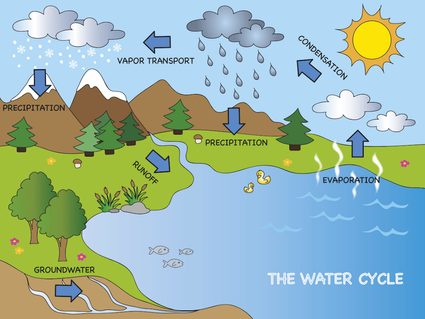Rainfall Calculator
This rainfall calculator will help you quickly calculate the volume of rainfall over a given catchment area depending on the amount of rain that has fallen. You can also use it to determine the area of land needed to collect a certain volume of rainfall. You will also learn how to calculate rainfall volume, why it might come in handy, and the science behind why it rains.
🔎 On the other hand, you can check our heat index calculator if you're wondering why it sometimes feels hotter than the reading we see on a thermometer.
Why does it rain? What does the water cycle look like?
Does the water cycle ring any bells for you? Are you now having flashbacks (or maybe nightmares) of your grade school science class? If you don't remember, here's a (kind of) basic refresher on the 5 stages of the water cycle.
- Step 1: The first stage of the water cycle is evaporation. Water at the surface absorbs heat from the sun and turns into water vapor.
🔎 The evaporation of water gives rise to vapor pressure. Learn more about this through our vapor pressure of water calculator.
-
Step 2: The next stage is condensation. When this water vapor reaches high altitudes where the temperature is low, the water vapor changes into tiny particles of ice or water droplets that come close together and form fog (near the ground) or clouds (across the atmosphere). Learn more about the clouds and their temperature by checking out our cloud base calculator
-
Step 3: This is the stage we've all been waiting for, folks. Are you still with me? Precipitation! When the wind or temperature changes, the water droplets combine to form bigger droplets. Eventually, the air can't hold any more water, and it precipitates. The water droplets will fall as rain, or if the temperature is below 0 degrees Celsius (or 32 degrees Fahrenheit, for our American reader), they will fall as snow.
-
Step 4: Precipitation also leads to runoff, the process where water runs over the Earth's surface (kind of like Usain Bolt).
-
Step 5: Last, but certainly not least, infiltration (which sounds more like a spy game than a water cycle stage, to be honest). Water moves deep into the soil, where it seeps down, creating pure and potable water.

How to calculate rainfall volume
Calculating rainfall volume sounds like a headache, but it's actually pretty simple. All you need to know is the following:
- The size of the catchment area, or area of land; and
- The depth of rain that falls onto the catchment area
You then multiply these two values, and tada - you get the volume of rainfall.
Why calculate rainfall volume?
Maybe you want to know how much water falls on your garden or your plot of land. Perhaps you want to find out how much runoff you can expect based on the land area. Wouldn't it also be neat if you could calculate how much water has contributed to a particular pond or lake over a year? For example, your backyard covers 50 m² and the average rainfall in your area yesterday was 5 cm. You can figure out exactly how much water fell on your property using the rainfall calculator!
How to use the rainfall calculator
This rainwater calculator is based on the rain catchment formula:
where:
- - rainfall water volume;
- - rainfall depth; and
- - catchment area.
and the catchment area in the rain catchment formula can be calculated as follows:
where:
- - catchment length; and
- - catchment width.
So to use this rainfall calculator:
- Enter the catchment area value. You can also click on
Advanced modeand input the length and width to have the catchment area automatically calculated for you. - Enter the rainfall depth.
- Alternatively, if you already have the rainfall water volume and want to figure out how big the catchment area is, you can enter the rainfall volume and rainfall depth to calculate the catchment area.
Don't worry about unit conversions. We've got that covered for you!
🙋 Are you wondering what if, because of colder temperatures, instead of rain, snow falls? How thick of snow would a certain rainfall depth be? Our rain to snow calculator can help you answer how much an inch of rain is when it falls as snow.
FAQs
How do meteorologists measure rainfall depth?
Meteorologists and hydrologists use rain gauges to measure the amount of liquid precipitation over an area during a predefined period. A rain gauge is also known as a pluviometer, udometer, ombrometer, or hyetometer. There are several types of rain gauges, including graduated cylinders, weighing gauges, tipping bucket gauges, and buried pit collectors.
What is the highest rainfall depth ever recorded?
The highest recorded rainfall in a single year was 26,470 mm (1,042 in) from 1860 to 1861 in Cherrapunji, Meghalaya, India. The most over a single day were 1,825 mm (71.9 in) in Reunion from January 7-8, 1966, during Tropical Cyclone Denise.
Which country has the highest precipitation volume?
Brazil has the highest precipitation volume in the world. In 2017, Brazil's precipitation volume was 14,995 billion cubic meters, which accounted for 13.75% of the world's precipitation volume that year (estimated to be 109,032.4 billion m³)!
How much water falls as precipitation each year?
About 505,500 km³ (121,000 mi³) of water falls as precipitation each year. Considering the Earth's surface area, that means approximately 990 mm (39 in) of precipitation globally each year.
How much is an inch of rain?
One inch of rain falling on one acre of ground is equal to about 27,154 gallons and weighs about 113 tons.